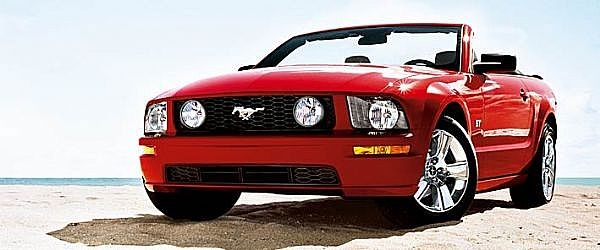
Ford's Mustang convertible is an American classic, now 46 years old. The Mustang was introduced mid-year at the 1964 New York World's Fair. The convertible solidified its reputation as a good looking, sporty, performance car in the film "Goldfinger" when Tilly Masterson's Mustang dueled with James Bond's Aston Martin in the Alps.
Mustang's reasonable price made the car a winner. Sales topped half a million in its first full model year. One of the best things about owning a Mustang convertible is that as long as you maintain it well, and choose the right model, it should retain much of its value. Today a mid sixties Mustang convertible in good shape can easily sell for more than $12 thousand. Back then it sold for less than $3K.
Start by learning which years to favor and which to avoid. Let's look at some general groupings. From 1964 through 1970, the car stayed faithful to its roots as a nimble fast drive. In 1971, thanks to mandated crash protection and bumper regulations, the car became bloated. The heavier pony no longer scampered; it handled like a boat. The car's condition worsened the following year. Horsepower dropped as did sales. 1973 was the last year for a factory made Mustang convertible for an entire decade. 1974 the Mustang II was born, an anemic cousin to the original car, based on the Ford Pinto. Power and performance dropped. It's possible to get Mustang convertible in a model year from this Dark Age, but don't bother. These were after market modifications for frustrated owners. Making a convertible is more than simply shearing off a roof. The entire body has to be reinforced to handle the extra torque that comes from having no overhead reinforcement. Mustang's third generation began in 1979 with a larger body, although the convertible didn't return until 1983. From 1994 to 2004 the Mustang went through another major redesign that included stylistic elements from the original models. Even though the convertible had been reintroduced 9 years before, 1994 is the first year since the original models that the rag top was restructured. The additional body stiffening gives 1994 and later models significantly better handling. The current generation of Mustang, beginning in 2005, was described by Ford's Senior Vice President of Design, J. Mays, as "retro-futurism," since the bodies echo the classic coupes of 1967 and 1968. In a nutshell, Mustang convertibles from 1964 to 1970 and from 1994 to today are the better choices. Newer technology makes the latter group perform better, with options like anti-lock 4-wheel disc brakes, fuel injection and independent suspension. Air bags on newer models are a safety plus. Later model Mustang convertibles offer other options that are now almost taken for granted, such as air conditioning, CD player, electric rear window defroster and leather seats.
Pounce on something distinctive. Carol Shelby was a former racer turned designer who made his impact on the Mustang line. If you are lucky enough to find a Mustang's Shelby G.T. 350 from 1966, buy it and restore it. Only 6 were made that year. In 1968, the top of the line Shelby convertible was the G.T 500 KR, King of the Road, with a Cobra Jet engine. Throughout the history of the Mustang, a variety of distinctive flavors were introduced that add distinctive value to the car, such as the High Country Specials, only offered in Colorado, Wyoming and Nebraska, with a unique color scheme; anniversary packages; high performance handling options; Boss and GT Mustangs. The enhancements make these cars collector items.
Learn how options affect resale. The original base model Mustang was a 110 horse power 6-cylinder engine that poked along. It's no wonder that 289 V-8's were soon outselling the 6's by a ratio of 3 to 1. Today, however, with no end in sight to gas price increases and better performing V-6's, you might want to consider a 6 instead of an 8. Also, manual transmissions save gas and offer better control of a car. In 1981, Mustang upgraded to a manual 5-speed, a kick to drive, but the number of people who drive a stick shift is shrinking and clutches are no fun in rush hour traffic. Although the supply of stick shifts is small, the demand is tiny as well. If you prefer a manual transmission, go for it. Just be prepared to look longer and then cast a wider net when you finally sell your Mustang.
Pay particular attention to the condition of the roof. It's known as a rag top for a reason. Expect to replace it. Although a white or light-toned roof will keep your car cooler in a sunny climate, it will show its age more readily than a black roof. If the temperature where you live leaves you sitting in rush hour traffic in the high 90's, you might want to consider a lighter roof, because chances are on those days you'll be putting up the roof and turning on the air condtioning until you can be cooled again by your car's movement.
Favor high performance tires. If the car you choose doesn't have them, plan on buying them. They will make a huge difference in how well your car hugs the road as the wind whips through your hair while you enjoy your new (to you) Mustang convertible.